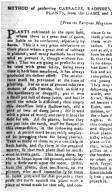[ Method of Preserving Cabbages, Radishes, and Turnips, and Other Such Plants, from the Game and Insects ]
Date: 1791/08/05
Source:
Nova Scotia Magazine
Institution: Nova Scotia Archives
| Source Origin: Nova Scotia Newspapers on Microfilm
| Reference: Microfilm Reels 8062, 8063
A remedy for keeping hares from vegetables using a mixture of asafoetida and dung juice followed by a recipe for preventing caterpillar infestation in cabbages. nn.490. Microfilm Reel 8063.
METHOD of preserving CABBAGES, RADISHES, TURNIPS, and other such
PLANTS, from the GAME and INSECTS.
[From the European Magazine.]
PLANTS cultivated in the open field,
where there is a great deal of game,
are liable to be consumed, especially by
hares. This is a very great misfortune in
those places where a great deal of cabbage
is planted; and many methods have been
used to prevent it, though without suc-
cess: That we are going to prescribe may
be tried with great safety, seeing every
time it hath been employed, it has always
produced the desired effect. The misfor-
tune must be prevented at the time of
planting. For an acre of ground take two
ounces of Assa Foetida, such as sold by
the apothecary or druggist; put it into
a small pot full of dung-juice, and boil it
until the whole is dissolved; then empty
this decoction into a shallow tub, add a
pint or two of dung-juice; stir it well
with a piece of wood, and carry it into the
field for use. All the plants, before they
are put into the earth, must be steeped in
this composition, in the following man-
ner: A person must be expressly employ-
ed in preparing them for being planted.
Take as many of them as you can clasp in
both hands, and dip them in the prepared
matter, so that each plant shall be moist-
ened in every part. This being done, lay
them in heaps upon the ground, and sprin-
kle a little earth upon the roots. Distri-
bute the plants, thus moistened, to the
planter, who must immediately set them
in holes prepared for that purpose; then
press the earth against the plant with a
piece of wood made for that use, and con-
__
tinue so to the end. No game will touch
these plants; but on the contrary avoid
them with great abhorrence and precipi-
tation. Yet, the plants which are either
not at all, or not sufficiently sprinkled will
soon be discovered and eaten by the hares;
so that the place must be replanted. There
is no danger of the plant’s contracting any
bad scent from this preparation; for the
sun and air will purify it in time. As for
caterpillars, and other insects, which bite
the young cabbage plants, radishes, &c.
They may be prevented very easily by the
following remedy:--Take a pail of dung
water, and infuse into it, of Assa Foetida
6 dwt. Woad 3 dwt. Garlick 3 dtw. Lau-
rel berries bruised 3 dwt. leaves or tops of
Elder, one handful; Carline, White Ca-
meleon, or Thistle root, one handful. Let
the whole digest for three days and three
nights. When you have occasion to use
this composition, take a whisp of straw,
and dipping it in the pail, sprinkle the
small plants that are infected by those in-
sects, which will soon perish or forsake the
place. -- To this remedy we will add ano-
ther, which is infallible against the cater-
pillars in cabbage. Sow with hemp all
the borders of the ground where you mean
to plant your cabbage, and you will see,
with surprize, that although the neigh-
bourhood is infected with caterpillars, the
space inclosed by the hemp will be perfect-
ly free; not one of the vermin will ap-
proach it.
Download: Transcription | Images
